Evangelia Dimitrakopoulou

There's a visceral sense of uneasiness in your installations. Can you talk a bit about what drives the desire to create this sensation in your practice?
Uneasiness is a residue of all the forms that the current reality is manifesting itself. I feel that Art (in all its aspects) should always be challenging the spectator and drive them to question what it is they are looking at, listening at, what they are experiencing unravelling in front of them. It should be challenging them to question the process of experiencing itself.
The act of looking on its own is distancing the bodies from the works themselves. There has to be a motion (a motion, emotion) for the separation to break. Even before the current pandemic, the atmosphere that each one of us was moving in was hazy and ambiguous. There is a deeply rooted alienation that enlarges the distance we already have from each other. I like researching the way we act when being in strange encounters. Language is struggling to adhere to familiar concepts, the mind works by recognizing elements that it has grown accustomed to. This struggle of pinpointing things, of finding and imposing meaning and at the same time the binary of attraction-repulsion gives rise to these visceral tendencies. All things liminal have this effect on us, dwelling in thresholds of the known, the relatable and the ineffable. This permits letting oneself experience more than what the rational understanding can provide us with. Such a mixture of fears of losing control guides the bodies into the space itself. How do we move when encountering what our species, our societies have defined as Strange, what we have been indoctrinated to deem as Other? How is that mirrored in our relations with those marginalized, deemed as Others, what do our thoughts produce as the outcome and how does the concept of thought-forms get added in the equation? A thought-form is what is birthed when a large population believes in something. It is how, in mythologies, Gods started existing and finally faded away, by a collection of sheer mind-created fantasies. These powerful ideas can physically manifest themselves by the power we give them. That is showing what belief, fantasies are able to achieve, how our definitions should be ever-changing. What is given does not reflect what is needed.
Is it the confinement of our minds that makes us so rigid or could it be linked to our physiology? Manuel de Lada says: “ soft tissue (gels and aerosols, muscle and nerve) reigned supreme until 5000 million years ago. At that point, some of the conglomerations of the fleshy matter-energy that made up life underwent a sudden mineralization and a new material for constituting creatures emerged: bones. It is almost as if the mineral world that had served as a substratum for the emergence of biological creatures was reasserting itself. We are walking, talking minerals.” . The visceral displaces us, shakes us out of this rigidity; it calls forth a different kind of optimism, a co-mingling one, it is through the mix of binaries that it can be summoned.
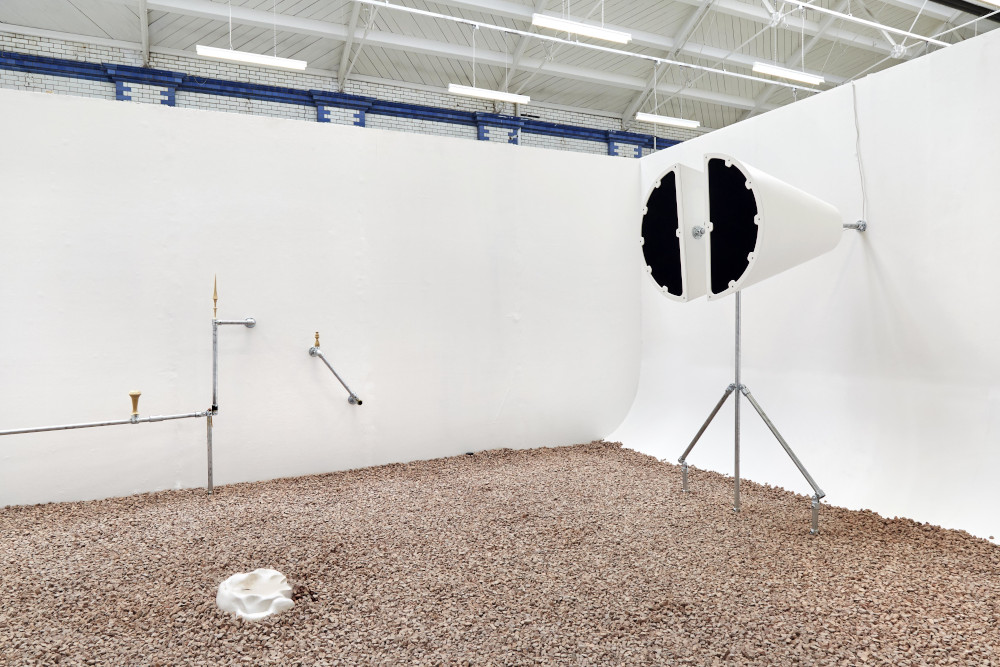
Industrialism, brutalism and what could be described as cosmic horror emerge as powerful motifs in your work. What draws you to these particular ideas?
I am interested in how different sets of power exist and blend into each other, how this mutation asserts itself: one is structural, the other is theological. Religions are bundles of rules and power enforcements. I have been drawn to the idea of Soft Control, something that resonates to what Keller Easterling talks about in her book “Extrastatecraft: the power of infrastructure”. By referencing and searching for infrastructure space organization, we can see the disposition of things slowly revealed. It uncovers “accidental, covert or stubborn forms of power” within urban spaces. It is a repertoire of politics that refuse to cohere around a fixed position or to state their own name. I see the elements of violent yet insidious control in my practice as different comments on the various hybrid manifestations of power, how deeply embedded and rooted they are in our everyday mundanity. We can get a glimpse of how power is asserting itself and how dread has slowly crippled in our collective psyche through events in our everyday life: the rise of racism, capitol occupations, murders of womxn by pathologies birthed by toxic masculinities. Power holds the reins when it comes to the decision of whether someone can exist in the Unreality it gives shape to, which is the purest form of governing and reigning over bodies: scapegoating, neglecting, desensitizing, marginalizing, othering instead of directly killing.
Industrialism and brutalism for me are acting as forms of oppression aesthetics. The places they frequent are highly elevated from the human level, creating this schism from everyday people and those in places of power. However, the way I approach them comes from a fetishistic almost perspective. I love to marvel in these strict, brutal forms and shapes. Concrete and metal structures have always been appealing to my eyes. It is also a game that I very much enjoy, that of using various elements and the dual meanings they entail. The male figures in my family were all mechanics and many of my first memories come from the shop they have had from before I was born. The space itself, the repetitive sounds of all the machines and the smell of oil and metal granules is something that drives my sense into an ecstatic crescendo. At the same time, my mother is a theologian which meant that there would always be a book of different religions kicking around in the house, something that ignited my fascination with theology, religions and the symbols they utilize in order to introduce faith and induce oppression. I find that these two worlds have blended the industrial, the brutalistic with the mythological and the processes of worship. Gods have been substituted by the production line.
Growing up in Athens played also a pivotal role in the development of my work and practice. With large amounts of mythologies in the school curriculum throughout the years, I grew fascinated by the way we invent and narrate stories. At the same time, the story of the Stranger, the Other was ever-present. Besides the appearance of monsters in stories, sphynxes, apotropaic architectural remnants, the idea of the Other is still deeply embedded in the Greek and Balkan societies. Strip away the shiny summery exterior, you find a rotten core of xenophobia, sexism, homophobia, casual rape culture which all constitute a vast part of our society. The rising issue of immigration and the election of a deeply corrupted right-wing party (that is in close contact with racist, neo-nazi beliefs and criminal organizations such as Golden Dawn) have summoned a monstrous hostility against free-thinking, queer culture, POC along with augmented surveillance, police enforcement and brutality. There is a feeling of a constant gaze being thrown on everyone, creating ever-growing feelings of anguish and dread.
SF has been one of my biggest crushes since I was a teenager. Besides my endless fascination for anything otherworldly, fleshy and overly bizarre, I have found that cosmic horror is a reflection of the alienated psychopathologies that have been created by neo-liberal societies. The way that we approach anything unfamiliar, alien to us is reflected in cosmic horror scenes where there seems to be an ode to our incapability of using words to describe the Unknown in front of our eyes. On the one hand, it leaves a vast space for things to be experienced, lived since language is not the most viable way to go forward. On the other hand, being stripped from words calls forward ideas of fascism, of not being provided with the chance to understand and to communicate. It promotes feelings of belittlement, nihilism and eventually giving up. However, borrowing the reference from Natasia Pattel and her text on Supereffective Platform, titled Technology and the Body, “Illegitimate offsprings are often exceedingly unfaithful to their origins.”. I would like to think that the use of those bleak bleak elements instead of a solely apprehensive and gloomy feeling, could speak of different paths leading to togetherness through exorcising and fully accepting.
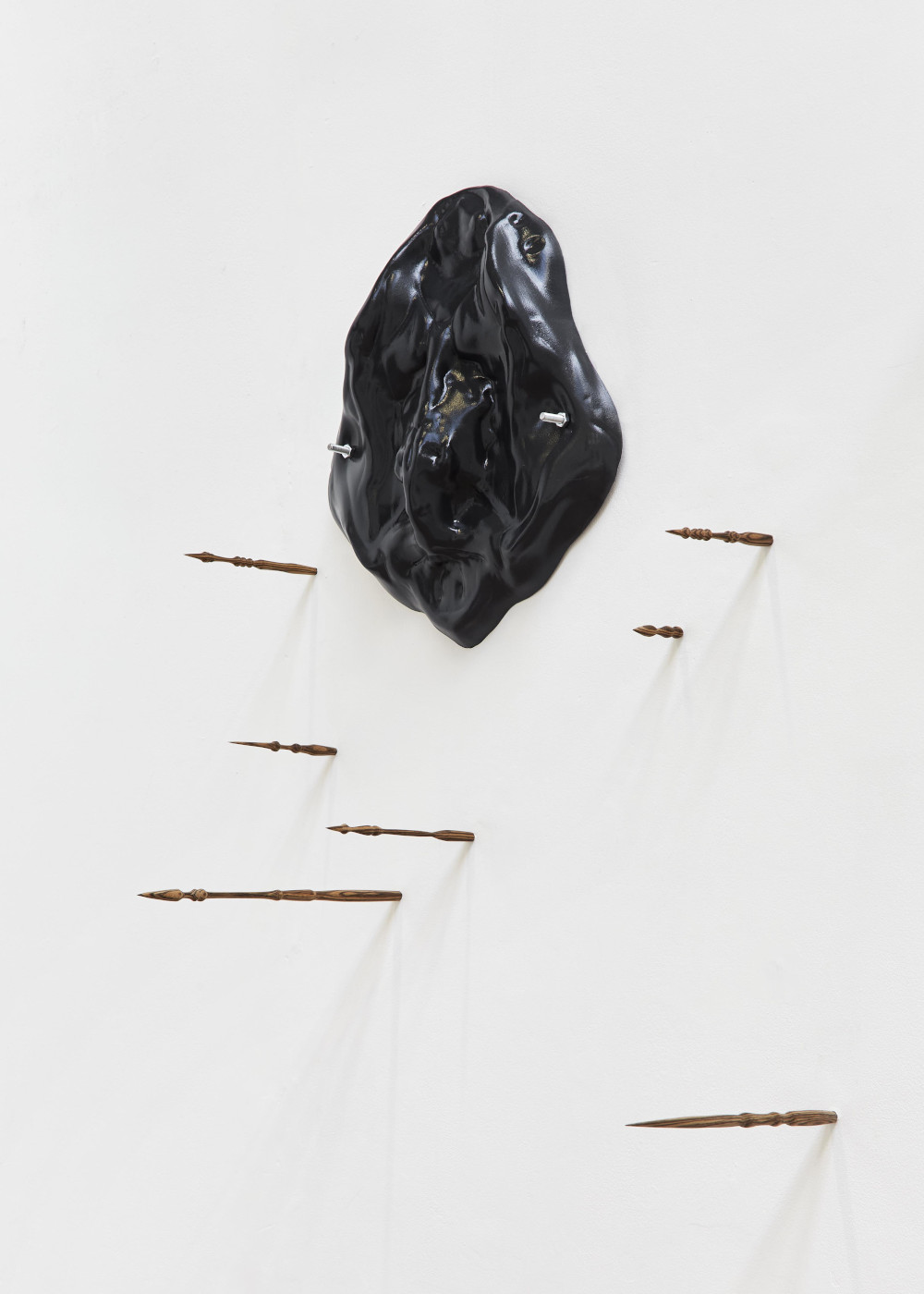
Your works often incorporate a barrage on the senses, leading to very immersive experiences. Can you talk about the significance of smell and sound-producing materials in your practice?
I am no musician yet I know what sort of things I like and make me twitch I go for that extreme feeling of bass in your ribcage, it is a good kick on those numb bodies of ours. I tend to prefer a “baroque” way when experiencing things, referring to an over-accumulation, a multiple over-layering of elements, textures, sounds, which might be a remnant of growing up in a Balkan country. You can feel the excess in multiple aspects of everyday life. “MAXIMUM VOLUME YIELDS MAXIMUM RESULTS” , my favourite line in an article on the performances of Sunn0))) in TheQuietus website from Agnus Finlayson. Stretching, expanding elements, reaching their extremes, seems like the optimal space to work in. Heavily referencing P.Sloterdijk’s Terror from the air and Brandon LaBelle’s Sonic Agency, the sonic and olfactory elements allow the sipping of the experience by multiple bodies at the same time. They create a thick layer, a newly birthed body in-between. Sound and smell are very rude in the sense (pun intended) that they do not ask for permission to invade you. Choosing to incorporate them and use them as dominating ingredients in a work is also in lieu of breaking the gazes hegemony in the hierarchy of the senses.
I have long been drawn to the ideas of mundane piercings which is how I like to call imperceptible infiltrations of any kind of stimuli that enter our bodies quietly and subterraneously. What unseen alterations are we subjected to in our everyday life? Are those outside forces something imperceptible, hidden casual under a mantle of mundanity? A blend of everyday perforations and the occasional Cthulean externality. This idea of piercings and penetrations came to form an obsession with making sharpened edges that create a feeling of apprehension. The tradition of the Evil Eye (Nazar) is a belief that originates in the Balkan peninsula and the Middle East. From what my research and my grandmother have told me, it is a form of malicious intent created by jealousy or spite. It is like people’s envy is materialized and it invades the target’s body causing headaches, nausea and in some stories bad luck and even death. I found a mosaic in Antiochia called the House of the Evil Eye which depicts an eye being pierced by a scorpion, a centipede, a sword, a trident, bitten by a cat, dog, lion and a satyr with a long phallus amongst many other things. It is also believed that it is more easily transmitted by blue or pale eyes. Everything is actively able to pierce you and invade you, even a set of eyes. This is reflecting the not so evident yet all-pervasive dread and psychotic paranoia that has been infused in our everyday lives.
My shift from the actual piercings towards the more ambiguous ones started through the research on that mosaic. I changed from the pinpointed to the diffused, to the creation of environments and atmospheres, because the ‘communicability’ of sounds, vapours and odours (along with viruses and microbes) is far greater than a sharpened edge that you might come into close proximity. The sharp has a lure but individuals have the choice to not engage with it should they not want to. However, when the ghostly elements mentioned above are put into the equation, they speak of insidious penetrations, imperceptible moves, cunning, silent “softness”. The bodies don’t have any of the information prior to their arrival so this consumption is based on an unfounded situation of trust. The spectator gets to the list of ingredients but there will never be a 100% certainty about it. We all are subject to stimuli consumption (information consumption) that is not easily perceived or detected, sipping into minds through the constant flow of information (I read somewhere that the data Earth generates in one day is equal to the data produced from 1000 to 2003). It is a transfer of signs, smells, noises. Any object, event, commodity can be replaced by algorithmic information capable of transforming that object or event into an exchangeable existence. Michel Serres named our era and societies as gaseous; it is focused on sciences of communications. He stated that “sensation, never pure, filters energies, encodes and passes on information: it transforms Hard into Soft, such as objects, commodities into the exchangeable existence”. This overconsumption is what brings forth the anxious character of contemporary living. Neoliberalism has targeted the soul as the main prey: two invisibilities targeting each other.
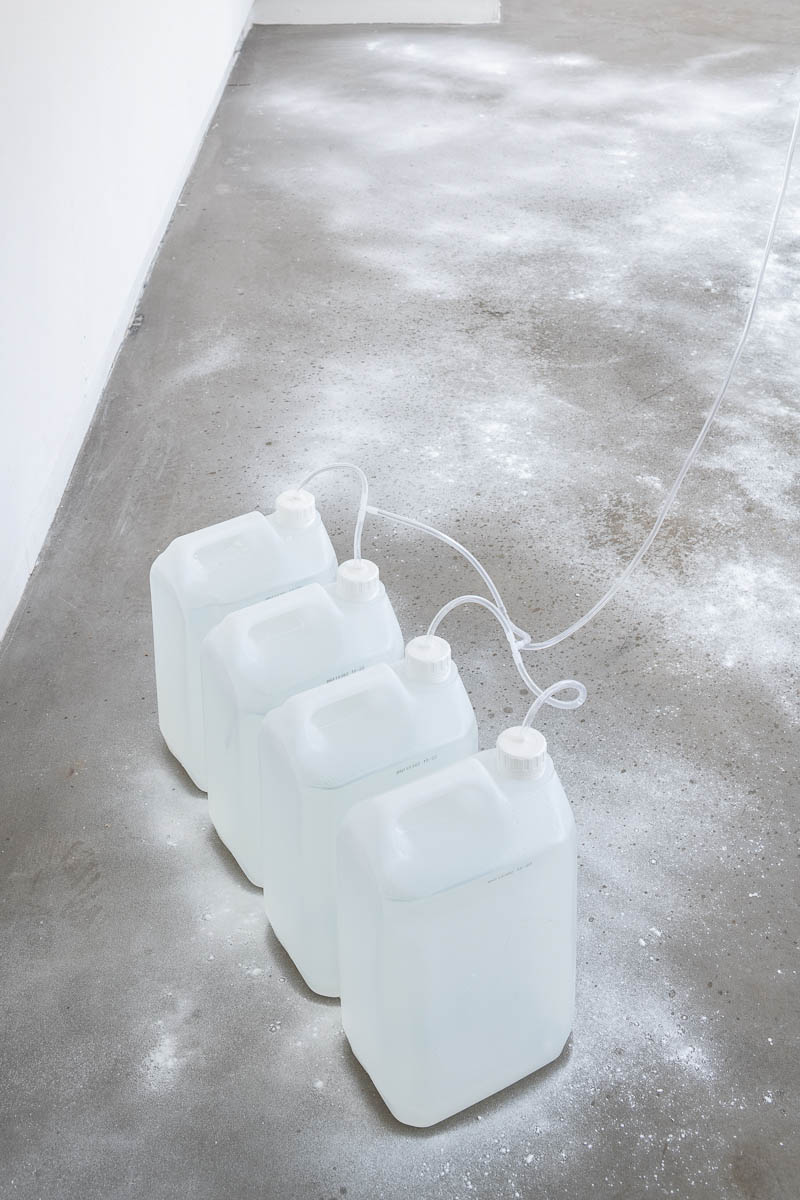
You recently completed a solo exhibition, Phaneromene, at PALFREY Gallery in London. Can you talk a little bit about that experience and the work you exhibited?
Phaneromene opened a week after the ending of our degree show in Goldsmiths. The timings being so close to each other were a tiny bit of an issue but that made the new work more versatile, more of an in situ installation. Having the opportunity to be there to set up 24/7, I had already decided that I want to play more with the space rather than with the objects created. The meaning of fanerono (φανερώνω) is to reveal. I was thinking of a hive, a collective “work”, multiple voices layering in one. Together yet apart, collective but distant. Connection is achieved through the communicability of dust, debris, sand, pollen, vapour; easily transported and exchanged, they are mediums of instant linking (resembling the immediacy of Internet lines and connections). As Luce Irigaray has reminded us, along with the global pandemic, air has stopped being the forgotten element; it is the mediation of all reflection, the medium of life, an ideal field for the spread of breaths and viruses. Remembering the air comes with a recognition of its materiality and mediating power. It speaks of spreads of contagious means, burrowings and silent piercings. The smallest droplet can give rise to a reverberation of matter that however imperceptible, remains consequential. It is not grandiose and loud but insidious and cunning. Spreading like gossip and feeding on the illusionary emptiness of space. Smart, insidious, cunning, we can see what the medium is saying but not what it is doing. Instead of excluding, it lures you in. This commingling experience, the creation of an augmented body in space, is referencing the thick atmosphere of raves. Thinking of the sweat evaporating inside the dimmed-light, smoke-filled, body-packed rooms, the borders of our bodies tend to get smudged.
Soda and vinegar are cupboard materials used to clean and sterilize surfaces. They produce a sizzling sound when mixed together along with foaming and bubbling. We are contained in various bigger and smaller bubbles, yet we contain many more ourselves. Our insides are as rich and filled as the air we breathe, the mixture of all of our breaths boiled down to one. We take part in an unlimited yet hushed and forced intimacy. Accessing processes works as a revelation of minuscule moves, of being surrounded and encompassed. The realization of the individual’s participation in a field of open-ended becoming, where breathing acts like a sting. Contagion speaks of the creation of spaces and vice versa. Interconnectedness is another form of virology.
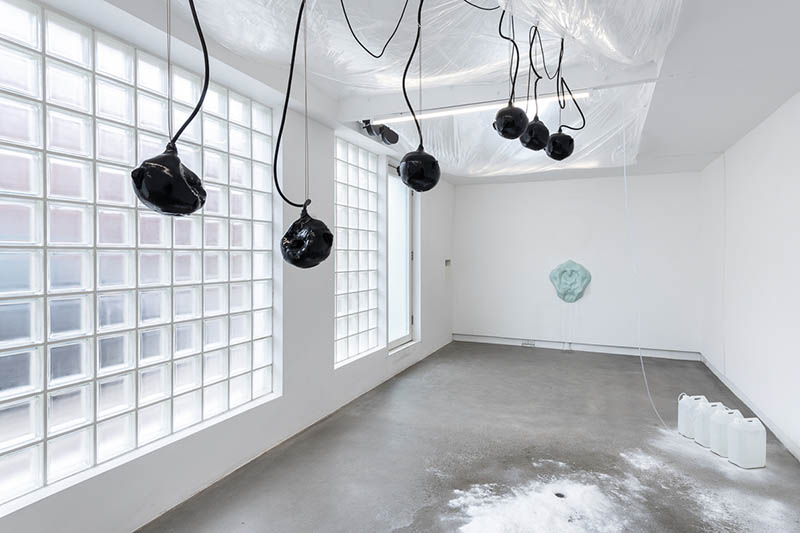
It would be great to hear about what you feel has been driving your work recently. What sources do you find yourself drawing from outside of the art world?
Can I just start by stressing how much I love Neon Genesis Evangelion? It is the gloomiest, goriest, most heavily religion- packed anime of all times. The despair and nihilism it has are always a source of inspiration.
Leaving the geeking on the side, I recently moved into my new studio through receiving the ACME award. Prior to that, the easiest thing that I could do were sound experiments and research. When I say research, it is not exclusively loaded with philosophical texts. My process looks more like having 78 tabs open on my laptop and at the same time 4 apps running in the background. I have been reading different works and texts that are heavily loaded with emotions regarding the Non-human and how we perceive it. One is Pharmako AI by K.Allado McDowell, the other iis The book of Promethea by Helene Cixous and lastly The Bluets by Maggie Nelson. They all have this strong connection with what we deem Other: one is an AI program that is concerningly relatable and empathetic, the Other is an embodied manifestation of the writer’s Word in a mare, the last is a colour that encompasses even the deepest parts of the writer's existence. There is a general feeling of giving in, of surrendering oneself to the flow of things unravelling. At the same time, I have been thinking of this newly founded taboo of proximity, of touch that has risen given our current times, repulsion and attraction yet again. Touching led to consumption and how easily we devour, that led to sexual acts and gag reflex, vomit as expelling, rejecting. So now I am reading on snake regurgitation and researching an African originated myth of snakes vomiting light. At the same time, I am furthering my amusement with tubes and the like, whatever lets circulations and leaks to happen. So I am now revisiting the works of Pauline Oliveiros and an archive of monstrosities focusing on hell-mouths. While writing as well, I like to paly with words since English is not my mother tongue. I tend to use the ‘mistakes’ I make. So hell-mouths become hole-mouths, whole-mouths, hell-holes, whole-howls.
I run. Running puts you into this ecstatic, endorphin filled position where your body just keeps going and takes over and your thoughts can get a bit dimmed for a split second. As artists, we carry our work in our head 24/7, there is never a day-off or a relaxing time. With running, this trance mode is necessary.
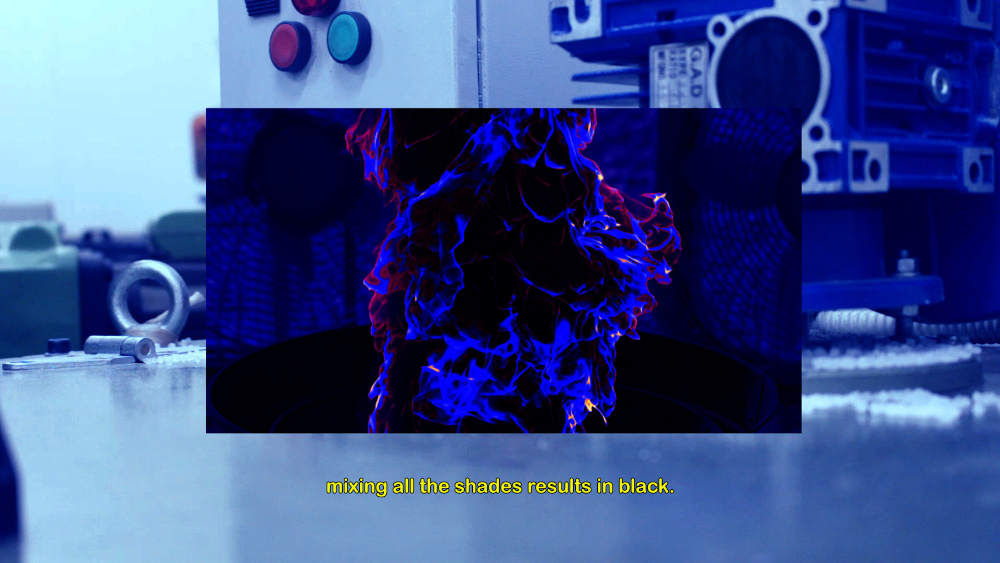
The elements of uneasiness, and the motifs you describe all come together so powerfully. Can you talk a bit about how you go from researching and thinking about these subjects to realising them in your installations?
I don’t think I can easily separate these two: research and the making. Having at some point followed the more “normative” way, if you will, of research prior to practice, I feel that it restricts the application of it afterwards. For example, if I am reading Bacchae and then try to incorporate that in my work, then it is a complete disaster, for me at least. I work with a lot of ‘failed’ experiments, I am not the kind of maker that waits until everything has sort of planned itself out, which does create a form of clutter around me. Chaotic neutral maybe. But through this process of accumulation and then extraction things become clear and then there is this ecstatic period where the research and the making get attuned and work in a complimentary way. Just the sheer act of making is a research on its own. Not prioritizing any of the two, their organic relationship is more fruitful. One day you are just stumbling upon a weird ad on the Internet on perfumes and cheap flights during the COVID 19 travelling crisis and then this colour that you picked for the latest resin test works as the binding agent. Music is also something that links things together for me. It is not difficult for elements to make sense in my head, you can feel it coming together in your guts. I know that when one uses sharp elements there is this unavoidable reference to danger and apprehension but at the same time you get this masochistic pleasure through interacting with them. And when one wants to refer to the workings of power, the more ‘uneasy’ the environment you create (whatever that might mean for someone as it varies according to many different sociological and personal reasons), the more loss of control you reference to. Symbols and their meaning can be always utilized but their twisting is what interests me more, which is what creates this uncanny element. You get to see a deep confusion when things and their translation do not fall into place.
What seems to be the real struggle is more the way towards the finding of the right words to describe and finally explain to yourself the reason behind your actions (or re-actions in this setting). One needs to try to become an observer themselves in multiple instances in order to see how it unfolds. So maybe a way to describe this ‘put-together’ process is to be first immersed inside the hazy waters of this abstracted initial layering and then take distance from it to really see what is in front of you.
Someone sent me the ten commandments that Captain Beefheart was working with when he was playing guitar and this one really stayed with me:
“If your brain is part of the process, you’re missing it. You should play like a drowning man, struggling to reach shore. If you can trap that feeling, then you have something that is fur bearing.”
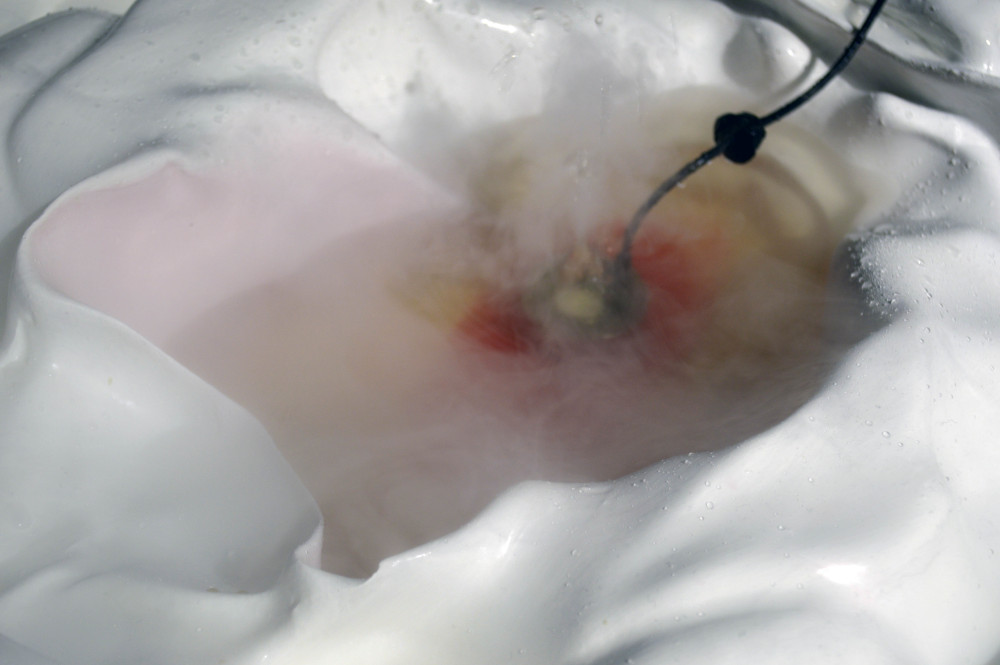
It sounds like you've been taking a lot in! With your new studio, how do you see your work developing over the coming year and beyond?
For sure yes, there have been some great instances and opportunities. At this moment I would like to try to maybe approach my making in a different way, mainly by pacing myself down a bit. I was always used to this fast pace, without taking any pauses or breaks, this chain-almost-producing. But since the whole world has slowed down I thought to get attuned to it. Yes (those furloughed) we have a lot of time in our hands and it is a huge privilege; but at the same time have you seen Ursula Le Guinn’s working daily schedule? We are not machines that need to be constantly running but there is also this deeply rooted guilt that comes out if you are not making anything. A friend once said that this has to do with our Christian upbringing. I also say that it is a symptom of our neoliberal societies yet I cannot seem to shake it off my system. So re-tuning my studio presence into my own rhythm is my current goal for now. At the same time I have been thinking about the Uncanniness of the mundane, what stories and burrowed monstrosities can resurface from the everyday element. So there are some things in mind starting to manifest in space related to our commodified experience of this world and the way it has mutated. But to be honest, I haven’t the slightest clue of how it will come to be looking like in a year’s time for example. I could never see myself working with smells or vapours before so it is a journey of surprises. One thing that I try to keep in mind is to be observant enough and recognize what the pieces demand, which way they show you to move towards. When open to these tiny hints, the way the work develops is explosive, intimidating and fascinating.
You can visit Eva's website at https://evangeliadimitrakopoulou.com/ and follow her Instagram account at https://www.instagram.com/d_mtrk/.
Eva asked if the following piece of writing about the current political situation in Greece could be included as a form of protest
It is a given now that there is something wrong with our blood in this country. There is no other way of explaining this hereditary demand of being undermined, beaten, taken advantage of and still going back to the perpetrator to ask for more. A combination of masochism and a huge dose of Stockholm syndrome for sure. They know how to hire 15.000 cops but they don’t provide places for doctors, they know how to go motocrossing in the mountains wearing no masks while taking group selfies on bikes yet they give fines to the elderly that go to grab their pension from the bank. They know how to visit islands during the middle of the bloody pandemic and have big meals out in the open without a sign of shame while the whole country is struggling mentally to be “OK”.
They know how to abolish the right to freedom and insert the police in universities for the first time after the fascistic regime of the 70’s. They know how to scare women leaving a single flower for those that died during that uprising while having forbidden any form of protest since this is the only way to take advantage of the pandemic towards their own fascistic interests. And they also know how to hide rapists, offenders under the blanket of traditional manliness.
It is a long list of atrocities that have been taking place ever since Kyriakos Mitsotakis came into power as the latest greek prime minister. The most recent and hideous is the enforcement of a law that forbids freedom in the artistic production. Taking as an excuse the protection of the state against terrorism they will be able to prosecute anyone that does not fit into their political agenda. Today, the 11th of February, friends and colleagues will be protesting in the center of Athens against the stripping of our freedoms. I wish I was there next to them to shout out from our lungs that we will not be deprived from the birth-right to create and to express ourselves freely.
Published 14 Feb 2021
